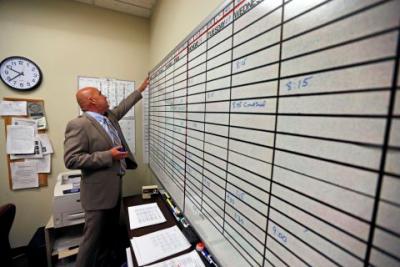Donna Bryson, Associated Press
CENTENNIAL, Colo. (AP) — Prosecutors had nearly wrapped up their case against a man accused of robbing six Iraqi immigrants in Aurora when the judge announced that the pair of Arabic interpreters assigned to the case was needed in another courtroom. Without an interpreter, the sixth Iraqi would not get to tell his story.
“It was just absurd to me that that was a possibility in this case,” Deputy District Attorney Kyle McCarthy said. “Luckily, in large part thanks to the interpreters realizing that this was an important trial for them to be at, they rearranged their schedule.”

McCarthy and fellow Deputy District Attorney Todd Bluth won convictions in the 2013 case that for them crystalized not just the need for more skilled interpreters but the challenges of pursuing justice in an increasingly diverse America.
“It’s important to realize that this is going to be an issue, and it’s a much bigger issue than people realize,” Bluth said.
It’s a national issue, with courts in Alaska seeking Hmong interpreters, or in New Mexico seeking Arabic. In some states, courts collaborate with other institutions — hospitals, schools, social service agencies — to ensure they cover the languages they need.
In 1960, only about a third of U.S. states had populations that were 5 percent or more foreign-born. By 2010, two-thirds of the states had populations more than 5 percent foreign-born. The U.S. Census Bureau says foreign-born people represent about 1 in 20 Americans.
Emy Lopez said that not so long ago, her staff of interpreters and translators for Colorado state courts handled about 50 languages. Now, while Spanish remains the most frequently needed language, court interpreters in Colorado are called on for more than 200 languages, from Adangbe (ah-DAHNG-beh), spoken in Ghana, to Zuni, a Native American tongue. Lopez said the increase is caused in part by changes enacted in 2011 that require interpreters be available for civil as well as criminal cases.
Spending for Lopez’s Office of Language Access increased from just over $2 million in 2003 to just over $4 million in 2013.
Colorado is a regional leader, loaning Mandarin court interpreters to Wyoming and a Vietnamese speaker to courts in several states.
Colorado also has a phone bank in Boulder where judges can call to speak to an interpreter. The service is for relatively simple proceedings, such as brief pre-trial hearings. At trials, interpreters work in person and in pairs, relieving each other every 20 minutes.
Miguel Buch, a Cuban-American who oversees the phone bank, started as a Spanish courtroom interpreter in Florida in the 1980s. Then, he said, it was common for lawyers to ask a relative of a defendant to interpret, or for freelancers to pick up work by advertising their services outside the courthouse. No one set standards or asked for credentials.
Today, interpreters in Colorado undergo criminal background checks and language-proficiency testing. They sign a code of conduct pledging, among other things, not to give legal advice. They are often asked for help beyond translation by defendants or victims who find themselves in confusing and frightening circumstances.
“We’re just trying to place them on the same level as anyone else walking into a courtroom,” Lopez said.
In Weld County, Spanish has long been and remains the language most often needed in court. Public defender Kevin Strobel, who has practiced there for three decades, said he has seen an increasing need in recent years for other languages, including those spoken in Somalia and parts of the former Soviet Union.
“Days long ago, you never would have had someone from Uzbekistan in Weld County,” he said.
Lopez, head of the court language office, said the 18th Judicial District near Denver is among the busiest for interpreters, with calls about 100 times a month for languages other than Spanish. The 18th district includes Aurora, among Colorado’s most diverse cities.
